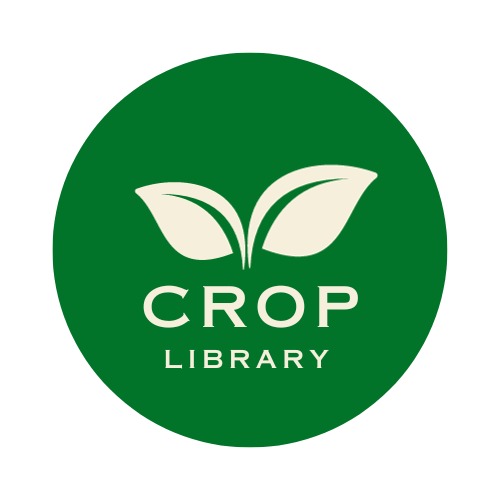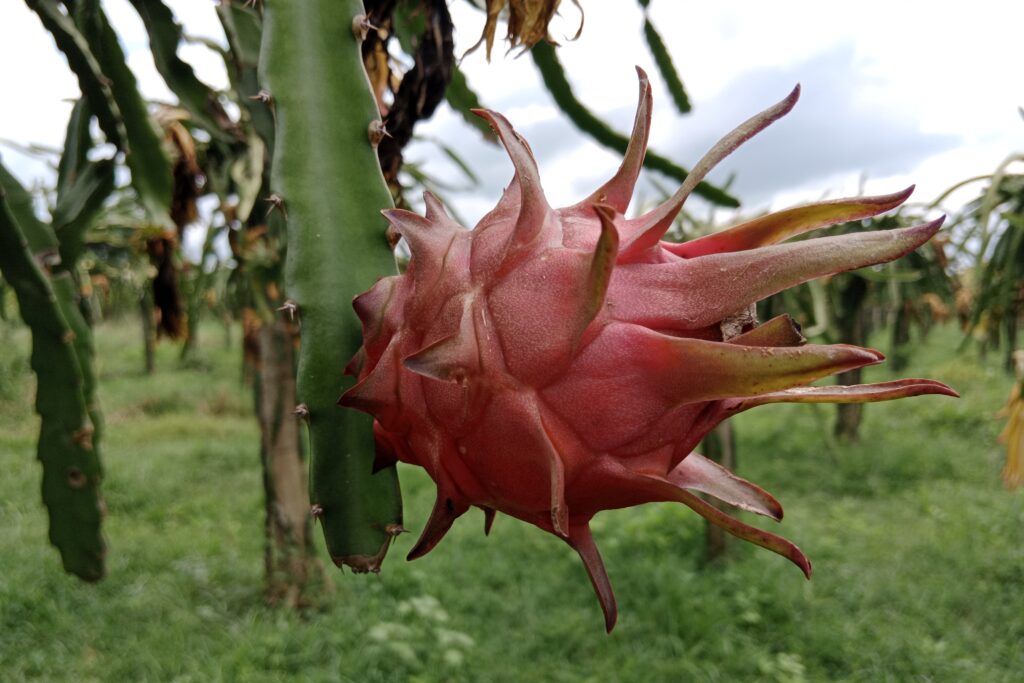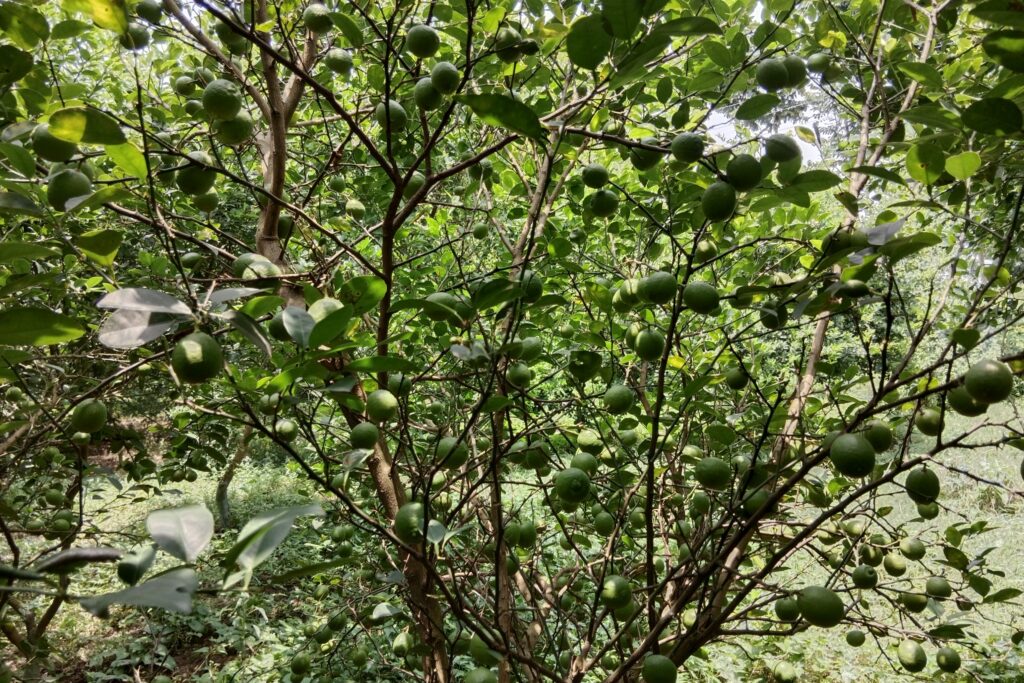Amaranthus Farming
Amaranthus, also known as pigweed, African spinach, or simply “green,” is a highly nutritious, fast-growing, and resilient leafy vegetable and grain crop. It is valued for its high protein, vitamin, and mineral content. Its ability to thrive in poor soils and withstand heat makes it an excellent crop for food security and commercial production.
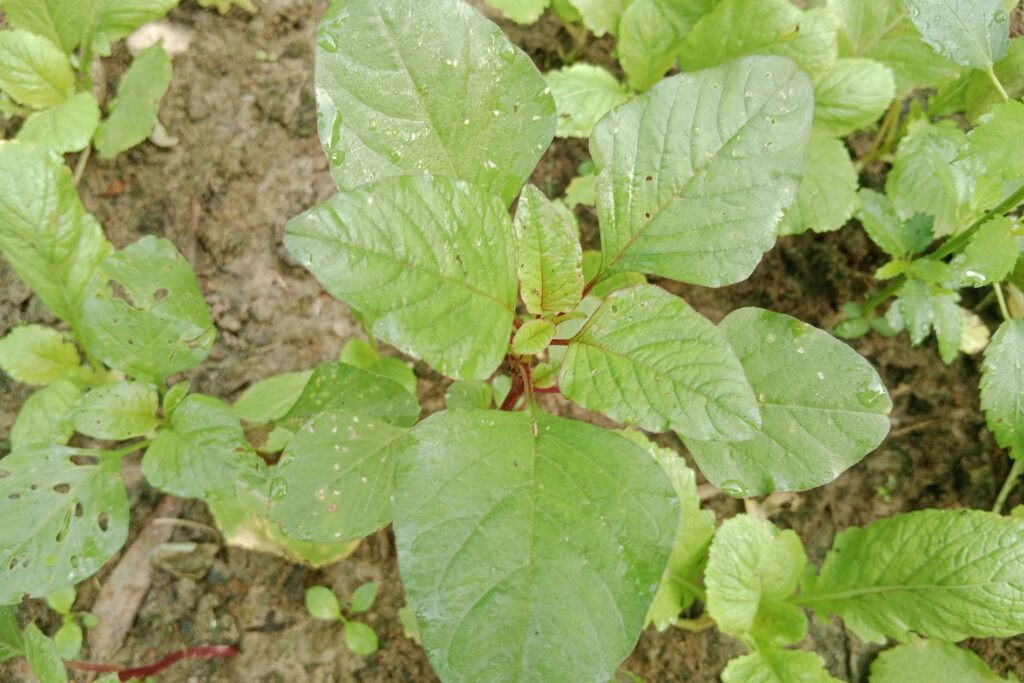
Amaranthus farming profit per acre is highly attractive for farmers looking for a fast-return, low-investment crop. With a total income of NRs. 200,000 against a cultivation cost of just NRs. 44,000, growers can earn a net profit of NRs. 156,000 per acre.
This translates to a remarkable profit margin of 354.5%, indicating that the income generated is more than three and a half times the initial investment. With a return on investment (ROI) of 3.54 times, Amaranthus proves to be an extremely profitable leafy vegetable crop for both commercial and small-scale farmers.
Land Preparation
Land preparation is carried out to produce a smooth, level, and weed-free soil surface that encourages uniform germination and strong seedling growth. The process usually starts with deep tillage—about 15 to 20 centimeters—to loosen compacted layers and mix in plant residues or unwanted vegetation.
This is followed by several passes of harrowing or rotary tilling to further break down soil lumps and create a fine, workable texture. Afterward, the field is leveled carefully to ensure that irrigation water spreads evenly and to prevent standing water. Finally, raised beds approximately one meter wide are shaped with furrows between them to enhance drainage and make crop maintenance more convenient.
Soil Type
Amaranthus species exhibit optimal growth in well-aerated, loamy soils with high organic matter content and good drainage. Nevertheless, the crop demonstrates considerable adaptability, performing satisfactorily in both sandy loam and clay loam substrates. It generally thrives within a slightly acidic to neutral soil pH range of 5.5 to 7.5 but can tolerate moderately alkaline conditions. This broad edaphic adaptability contributes to its successful cultivation across diverse agroecological zones.
Climatic Requirements
Amaranthus is classified as a warm-season species, exhibiting optimal physiological performance within a temperature range of 22°C to 30°C. The crop is highly susceptible to frost injury, which can significantly impair germination and vegetative growth.
It performs best under moderate precipitation levels of approximately 500–700 mm per growing cycle. Although the plant develops a notable degree of drought resilience after establishment, a consistent supply of soil moisture is required to ensure high-quality leaf production.
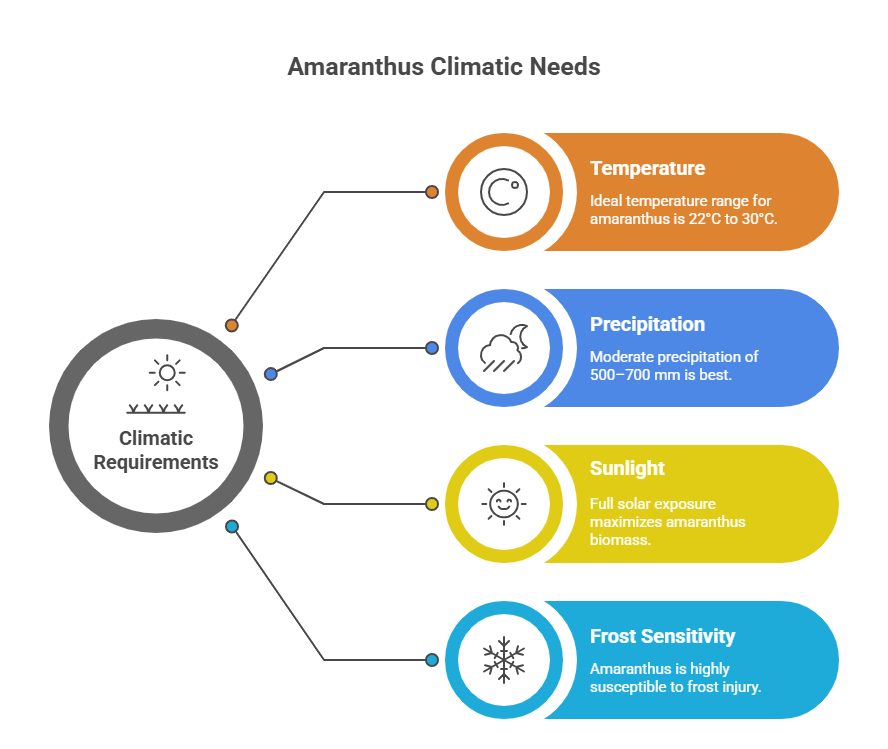
Furthermore, Amaranthus attains maximum biomass accumulation under full solar exposure, though it can withstand partial shading without severe yield reduction.
Major Cultivars
Cultivars of amaranthus are generally classified based on leaf color, plant height, and purpose of cultivation, whether for leaf or grain production, while locally adapted landraces are also commonly grown in specific regions due to their suitability to local conditions.
For Leaf Production
For leaf production, red varieties such as ‘Co-1’ and ‘Arun’ are preferred for their high anthocyanin content, while green varieties like ‘Co-2’, ‘Co-3’, and ‘Chhoti Chaulai’ are commonly cultivated for their high yield and tender foliage.
For Grain Production
For grain production, high-yielding varieties commonly cultivated include ‘Annapurna’, ‘Suvarna’, ‘GA-2’, ‘RMA-4’, and ‘PRA-1’.
Propagation
Propagation of amaranthus is primarily done through seeds, with direct seeding being the most common method, although transplanting is also practiced, particularly for achieving an early harvest or when grown under controlled conditions.
Seed Rate per Acre
| Cultivation Purpose | Sowing Method | Seed Rate per Acre |
| For Leafy Types | Direct Seeding | 1 – 1.5 kg |
| For Grain Types | Direct Seeding | 0.5 – 1 kg |
| For Transplanting | Nursery (for raising seedlings) | 200 – 400 grams |
Nursery Management
For nursery management, prepare a small, finely tilled nursery bed enriched with well-decomposed compost, then mix the tiny amaranthus seeds with sand or ash to ensure even broadcasting and sow them thinly before covering with a very light layer of soil or compost. Water the nursery gently and regularly to maintain moisture without waterlogging, and the seedlings will be ready for transplanting in 3–4 weeks when they reach a height of 10–15 cm and develop 3–4 true leaves.
Planting
a). Planting Season
The planting season for amaranthus includes the Kharif or rainy season, when sowing begins with the onset of the monsoon in June–July, and the summer season, with sowing done from February to March, which requires supplemental irrigation for proper crop establishment.
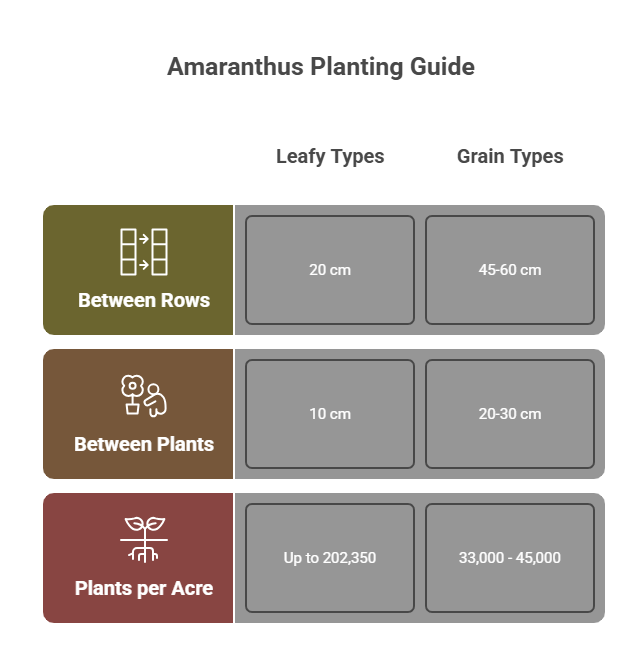
b). Spacing
| Plant Type | Between Rows | Between Plants |
| Leafy Types | 20 cm | 10 cm |
| Grain Types | 45-60 cm | 20-30 cm |
c). Planting Method
Amaranthus can be planted either by direct seeding, where seeds are broadcast or drilled in shallow furrows 1–2 cm deep, or by transplanting, where seedlings are carefully uprooted from the nursery, often with a ball of soil, and planted in prepared pits, followed by immediate watering to ensure proper establishment.
d). Number of Plants per Acre
| Cultivation Purpose | Number of Plants per Acre |
| Leafy Types | Up to 202,350 |
| Grain Types | 33,000 – 45,000 |
Intercropping
Amaranthus is well-suited for intercropping because of its fast growth and upright habit, commonly being grown alongside maize, cassava, or young fruit orchards such as mango and citrus, and it can also serve as a companion crop with slower-growing vegetables.
Irrigation
Amaranthus requires consistent moisture during critical stages such as germination, seedling establishment, and active leaf growth, with light and frequent irrigations being ideal; depending on soil and climatic conditions, irrigation should be applied every 5–7 days during the dry season, using furrow or sprinkler methods while avoiding waterlogging.
Fertilizer and Manure
For optimal growth, amaranthus requires both organic and inorganic fertilization, starting with a basal application of 10–15 tons of well-decomposed farmyard manure (FYM) or compost per acre during land preparation, along with biofertilizers such as azospirillum, phosphorus-solubilizing bacteria (PSB), and potash-mobilizing bacteria at 800 g each per acre.
In addition, inorganic fertilizers should be applied per acre with nitrogen (40–60 kg) split into half as basal and half as top dressing 3–4 weeks after sowing, phosphorus (25–35 kg P₂O₅) applied fully as a basal dose, and potassium (20–30 kg K₂O) also applied entirely as a basal dose.
Weed Control
Weed control in amaranthus is crucial during the first 3–4 weeks after sowing, with 1–2 manual hand weedings recommended, the first typically conducted 2–3 weeks after sowing; while pre-emergence herbicides such as Pendimethalin can be applied immediately after sowing, chemical control is less common in small-scale or organic production.
Interculture Operation
Interculture operations for amaranthus include thinning direct-seeded crops to the recommended spacing once seedlings have developed 2–3 true leaves, with the thinned plants usable as greens, while training and pruning are generally not practiced for leafy types, which are harvested whole or through repeated cutting, though for grain varieties, removing side shoots (suckering) can help direct energy to the main panicle.
Flowering and Fruit Management
Flowering and fruit management in amaranthus vary depending on the type being cultivated. For leafy varieties, flowering is undesirable because it causes the leaves to become bitter and fibrous, so harvesting is carried out before bolting, or the formation of flower stalks, to maintain tender, flavorful foliage.
In contrast, flowering is the primary goal for grain varieties, as plants develop large, showy panicles that are essential for seed production. To ensure good grain set, it is important to provide adequate moisture and nutrient availability during panicle development, supporting healthy flowering and optimal yield.
Pest and Disease Management
Major Pests
a) Aphids & Leafminers
Aphids and leafminers suck sap and create tunnels in leaves, reducing plant vigor and yield. For control, neem-based insecticides such as neem oil at 5 ml per liter of water can be sprayed at 7–10 day intervals. In case of severe infestation, systemic insecticides like Imidacloprid 17.8% SL at 0.3 ml per liter of water can be used, ensuring thorough coverage of the underside of leaves where pests usually hide.
b) Caterpillars
Caterpillars feed on foliage and can significantly reduce leaf biomass. They can be hand-picked in small-scale crops, especially during early infestation. For biological control, apply Bacillus thuringiensis (Bt) at 1–1.5 grams per liter of water. Spray during late evening hours for better effectiveness, as caterpillars are more active during this time.
c) Flea Beetles
Flea beetles cause small shot-hole damage in young leaves, which can severely stunt early plant growth. For management, neem extract at 5 ml per liter can be used as a preventive spray. If the infestation is intense, apply Lambda-cyhalothrin 5% EC at 0.5 ml per liter of water, targeting the base of the plants and surrounding soil where beetles tend to hide.
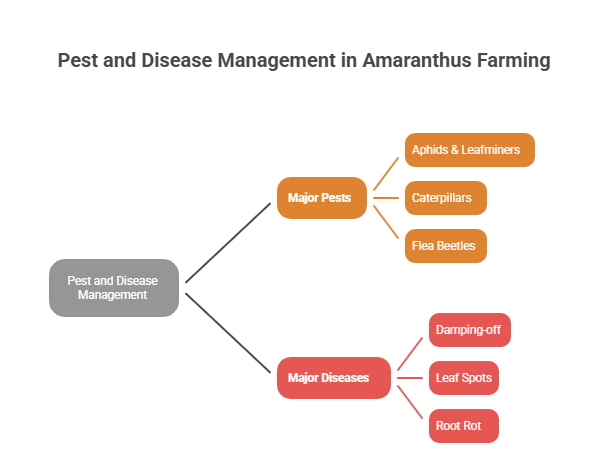
Major Diseases
a) Damping-off
Damping-off is a common nursery disease that affects young seedlings, causing them to collapse and die at the soil line. It is usually triggered by excessive moisture and fungal pathogens like Pythium and Rhizoctonia. To prevent this issue, avoid overwatering and ensure proper aeration in the nursery bed. Treat seeds before sowing with Thiram or Captan at 2–3 grams per kilogram of seed to reduce fungal infection risk.
b) Leaf Spots
Leaf spot diseases appear as brown or black lesions on the leaves, eventually leading to premature leaf drop and reduced photosynthetic activity. To control this, spray Mancozeb 75% WP at a dose of 2.5 grams per liter of water or Copper oxychloride 50% WP at 3 grams per liter of water. Apply at 10–12 day intervals and ensure complete coverage of the foliage for effective protection.
c) Root Rot
Root rot is caused by prolonged waterlogging and soil-borne fungi, leading to yellowing, wilting, and eventual death of plants. Maintaining proper field drainage is essential to prevent its occurrence. In affected areas, drench the soil around the root zone with Carbendazim 50% WP at 1 gram per liter of water to suppress fungal growth and protect healthy plants from further infection.
Harvesting
Leafy Amaranth
Harvesting in amaranthus can be done using two methods: the pull-and-replant method, where entire young plants are uprooted 3–4 weeks after sowing, and the cut-and-come-again method, in which plants are cut 5–8 cm above the ground to allow for 2–3 regrowth cycles, with subsequent harvests every 2–3 weeks, starting from the first harvest typically done 4–5 weeks after sowing.
Grain Amaranth
Grain amaranth is harvested once the seeds reach full maturity and the panicles change color from green to straw, brown, or a vibrant shade depending on the cultivar, which typically occurs 90–120 days after sowing. At this stage, the mature panicles are cut and left to dry properly to reduce moisture content, after which they are threshed manually or mechanically to separate the grains, ensuring clean and dry produce suitable for storage or further processing.
Yield
| Crop Type / Purpose | Yield (per acre) |
| Leafy Amaranth (Fresh Greens) | 6,000 – 10,000 kg |
| Grain Amaranth | 400 – 800 kg |
Cost of Investment per Acre for Amaranthus Farming
| S.N. | Categories | Cost for Investment (NRs.) |
| 1 | Land Preparation | 15,000 |
| 2 | Seed | 1,000 |
| 3 | Seed Sowing | 1,000 |
| 4 | Fertilizers and Manure | 8,000 |
| 5 | Irrigation | 5,000 |
| 6 | Weed Control | 2,000 |
| 7 | Pest & Disease Control | 2,000 |
| 8 | Harvesting | 5,000 |
| 9 | Miscellaneous Costs | 5,000 |
| Total Investment Cost | 44,000 |
Income per Acre from Amaranthus Farming
| Particulars | Estimated Yield / Acre (Kg) | Market Price (NRs. / kg) | Total Income (NRs.) |
| Fresh Leaves | 10,000 | 20 | 200,000 |
| Total Income | 200,000 |
Analysis of Amaranthus Farming Profit Per Acre
| Particulars | Amount (NRs.) |
| Total Income | 200,000 |
| Total Cost | 44,000 |
| Net Profit | 156,000 |
| Profit Margin (%) | 354.5% |
| Return on Investment (ROI) | 3.54 times investment |
With a total income of NRs. 200,000 and the cultivation cost of NRs. 44,000, Amaranthus farming generates a net profit of NRs. 156,000 per acre. This results in a high profit margin of 354.5%, meaning the earnings are more than three and a half times the initial investment. Overall, the return on investment (ROI) stands at an impressive 3.54 times the amount invested, highlighting the excellent profitability of this crop.
Crop Calendar of Amaranthus Farming
| Period (Days/Week after Sowing) | Key Operations & Activities | Description / Key Notes |
| Pre-Planting (1-2 weeks before sowing) | 1. Land Preparation 2. Basal Fertilizer Application | – Deep ploughing, harrowing, and levelling. – Prepare raised beds (~1m wide) with furrows. – Incorporate 10-15 tons of FYM/compost per acre. – Apply full dose of Phosphorus (P₂O₅) and Potassium (K₂O), and half dose of Nitrogen. |
| Day 0 (Sowing) | 1. Planting | For Leafy Types: – Direct seeding: 1-1.5 kg/acre, broadcast or drilled. – Spacing: 20 cm between rows, 10 cm between plants. For Grain Types: Transplanting: Use 3-4 week old seedlings from a nursery. |
| Week 1 – 3 | 1. Irrigation 2. Weed Control 3. Thinning | – Ensure consistent soil moisture for germination and establishment. Irrigate every 5-7 days in dry conditions. – Perform first manual weeding 2-3 weeks after sowing. – Apply pre-emergence herbicide (e.g., Pendimethalin) just after sowing if needed. – Thin direct-seeded crops to recommended spacing. Thinned plants can be used as greens. |
| Week 3 – 4 | 1. Top Dressing 2. Pest & Disease Monitoring | – Apply the remaining half dose of Nitrogen fertilizer. – Monitor for pests like aphids, leafminers, and flea beetles. Use neem-based sprays or recommended insecticides if infestation occurs. |
| Week 4 – 5 onwards (Leafy Types) | First Harvest | Leafy Amaranth is ready for first harvest. – Pull-and-Replant Method: Uproot entire young plants. – Cut-and-Come-Again Method: Cut plants 5-8 cm above ground. This allows for 2-3 regrowth cycles. |
| Week 6 – 12 (Leafy Types) | Subsequent Harvests | – For the “cut-and-come-again” method, subsequent harvests can be done every 2-3 weeks. |
| Week 4 – 12 (Grain Types) | Vegetative Growth & Flowering | – Plants grow vigorously. Flowering begins for grain types. – Ensure adequate moisture and nutrient availability during panicle development. – Continue monitoring for pests (especially caterpillars) and diseases (Leaf Spots). |
| Week 13 – 16 (Grain Types) | Maturation & Harvest | Grain Amaranth reaches maturity (90-120 days). – Panicles change color from green to straw, brown, or vibrant shades. – Cut panicles and leave to dry. – Thresh manually or mechanically to separate grains. |
Sources
JICA
University of California Agriculture & Natural Resources (UC ANR)
Punjab Agricultural University (PAU)
Tamil Nadu Agriculture University (TNAU) – Agritech portal
Indian Council of Agricultural Research (ICAR)
Nepal Agricultural Research Council (NARC)
U.S. Department of Agriculture (USDA).
Ministry of Agriculture and Livestock Development (Nepal)
Disclaimer: This crop farming profits assume optimal conditions. Actual results may vary depending on climate, market prices, and farm management practices.
